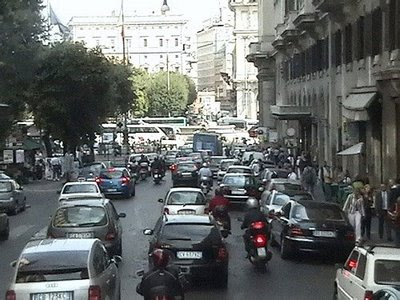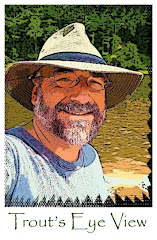When In Rome.....
Do As The Romans Do?
I Don't Think So....
We're Tourists!
While the people of Rome are going to work, here are some of the sites you don't want to miss while we are in Rome:
Coliseum
The Roman Coliseum is an elliptical amphitheatre in the center of the city of Rome, the largest ever built in the Roman Empire. It is 187m at its longest end and 155 m at its shortest. The height of the external ring reaches 50m from ground level. Around the exterior run three orders of arches, respectively adorned with Doric, Ionian, and Corinthian columns and a fourth floor with Corinthian pilasters. The building had 80 arched entrances allowing easy access for the 55,000 spectators. It is one of the greatest works of Roman architecture and Roman engineering. It is east of the Roman Forum, its construction started between 70 and 72 AD under the emperor Vespasian and was completed in 80 AD under Titus. The Coliseum is capable of seating 55,000 spectators, and was used for gladiatorial contests and public spectacles. As well as the gladiatorial games, other public spectacles were held there, such as mock sea battles, animal hunts, executions, re-enactments of famous battles, and dramas based on Classical mythology. The building ceased to be used for entertainment in the early medieval era. It was later reused for such purposes as housing, workshops, quarters for a religious order, a fortress, a quarry, and a Christian shrine. It has been estimated that about 500,000 people and over a million wild animals died in the Coliseum games.
Roman Forum
The Roman Forum is located in a valley that is between the Palatine hill and the Capitoline hill. It originally was a marsh, but the Romans drained the area and turned it into a center of political and social activity. The Forum was the marketplace of Rome and also the business district and civic center. It was expanded to include temples, a senate house and law courts. When the Roman Empire fell, the Forum became forgotten, buried and was used as a cattle pasture during the Middle Ages. In the area around the Forum, the city was also home to markets, shops and taverns. You could also find the typical Termopolia, which were the ancient equivalent of today's fast food restaurants. In short, the Forum was the heart and soul of city life. It was in Caesar's time, when Rome has become the capital of a vast empire, that the Forum became a place for celebrations and in the Imperial era it was the symbol of the Empire.
Much of the forum has been destroyed. Columns and stone blocks are all that remain of some temples. The arch of Titus and the arch of Septimius Severus still stand and are in good shape. Like many other ancient Roman buildings, stone blocks have been removed from the Forum and used to build nearby churches and palaces.
Things to see while at the Forum: Arch of Septimus Severus, Arch of Titus, House of the Vestal Virgins, Temple of Saturn, The Arch of Constantine, Temple of Vespasian and Titus, Temple of Vesta, Palatine Hill, and Capitoline Hill.
Pantheon
When the ancient Romans built their temples, they often built a tall staircase to the front to protect the building from frequent floods of the Tiber River. The Pantheon was no exception. It's hard to believe today when seeing the Pantheon that at one time there were 15 steps leading to the front door. Now, over the centuries, dust and debris has covered those step and raised the front to the level of the street.
Originally a temple for all pagan gods, the temple was converted into a church in 609. The Pantheon now contains the tombs of the famous artist Raphael and of several Italian Kings. Its ecclasiastic interior design contrast with the temple's structural design, but the marble floor - which features a design consisting of a series of geometric patterns - is still the ancient Roman original.
The most remarkable part of the building is the more than 43 meter high dome. It was the largest dome in the world until 1436 when the Florence Cathedral was constructed. At the top of the dome is a large opening, the oculus, which was the only source of light. The front portico has three rows of 8 columns, each one with a diameter of 1.5m. A huge bronze door gives access to the cylindrical building. Its diameter equals the interior height of 43,3m.
Trevi Fountain
The Trevi fountain is at the ending part of the Aqua Virgo, an aqueduct constructed in 19 BC. It brings water all the way from the Salone Springs (approx 20km from Rome) and supplies the fountains in the historic center of Rome with water. The central figure of the fountain, in front of a large niche, is Neptune, god of the sea. He is riding a chariot in the shape of a shell, pulled by two sea horses. Each sea horse is guided by a Triton. One of the horses is calm and obedient, the other one restive. They symbolize the fluctuating moods of the sea. On the left hand side of Neptune is a statue representing Abundance, the statue on the right represents Salubrity(healthiness). Above the sculptures are bas-reliefs, one of them shows Agrippa, the general who built the aqueduct that carries water to the fountain. The water at the bottom of the fountain represents the sea. Legend has it you will return to Rome if you throw a coin into the water. You should toss it over your shoulder with your back to the fountain.
Next week we visit Vatican City. Vatican City is the smallest sovereign state in the world.









Let's go to the forum!
ReplyDeleteI hear American Idol will be hosted in the forum next season.
ReplyDeleteWow, to see all this we are going to have to save time and use the Termopolia.
ReplyDeleteCan we 'Maximus' size that order?
ReplyDelete